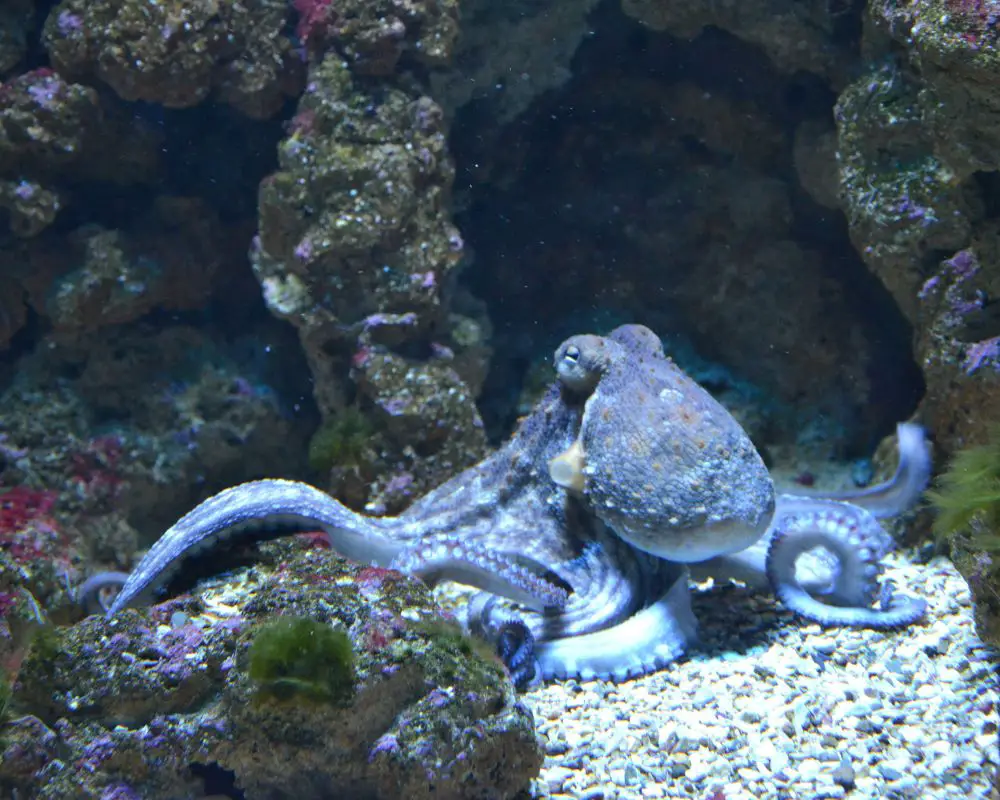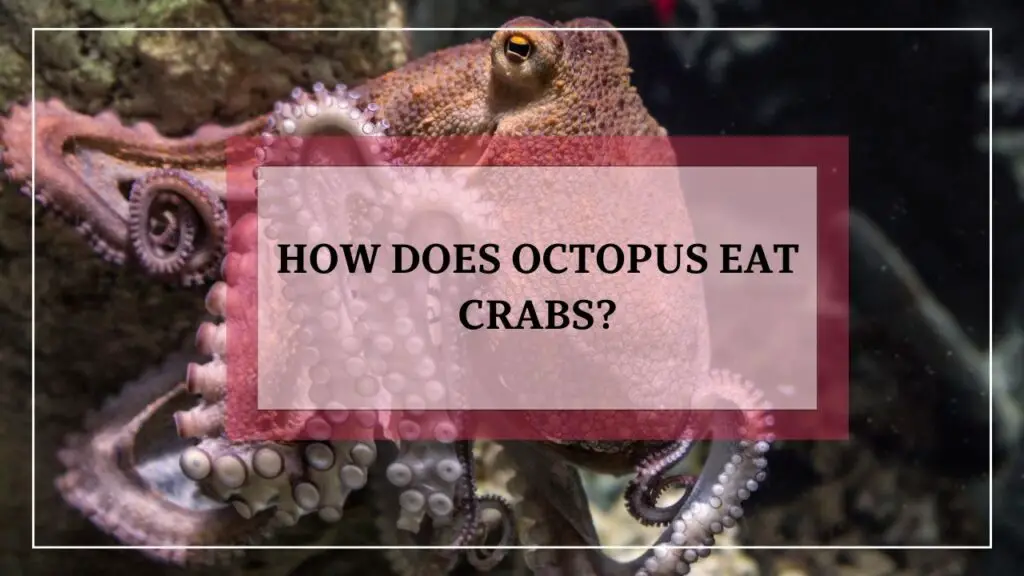Have you ever wondered how the incredible octopus catches and eats its crabby prey? Well, get ready to dive into the depths of the underwater world as we unravel the mysteries of octopus feeding habits.
Octopuses are like the magicians of the ocean, with their amazing abilities to blend in with their surroundings and outsmart their prey.
Just like a superhero with a secret power, these clever creatures have special adaptations that make them expert hunters. And their favorite meal? Crabs!
But that’s not all – octopuses are incredibly smart too! They can solve problems and learn from their experiences, which helps them come up with clever hunting and eating strategies.
In short, Octopuses eat crabs by catching them with their tentacles, immobilizing them, and then using their powerful beak to crush the crab’s exoskeleton. They consume the soft tissues first before moving on to the harder parts.
Octopuses have a radula, a rough tongue-like organ, which scrapes and shreds the crab’s flesh, allowing them to extract every edible portion. They have a clever feeding strategy, starting with the crab’s appendages and avoiding consuming indigestible parts like the exoskeleton.
So, if you’re curious to know how these magnificent creatures eat crabs despite their strong bodies, stick around!
The Feast: How Do Octopus Eat Crabs?

The octopus has successfully caught its crabby prey, and it’s time for a feast. Let’s dig into the ways the octopus devours its treat!
Beak And Radula: The Octopus’s Super Tools
Let’s talk about the octopus’s beak! No, it’s not a beak for chirping like a bird, but it’s a powerful tool that helps the octopus crack open the crab’s exoskeleton. Just imagine having a little pair of pliers in your mouth![1]
This beak is made of hard, durable material, like the beaks of birds, and it’s perfectly shaped to crush through the crab’s tough outer shell. It’s like the octopus’s secret weapon to gain access to the mouthwatering meat inside the crab.
When an octopus encounters a crab, it brings its beak into action. With a firm grip on the crab using its powerful tentacles, the octopus skillfully maneuvers its beak to apply just the right amount of force. Crunch!
That’s the sound of the exoskeleton breaking under the pressure. It’s like the octopus is saying, “Open sesame!” Once the exoskeleton is cracked, the octopus can dig into the delicious, tender meat that awaits inside. It’s like a perfectly orchestrated break-in at a gourmet crab feast!
Radula Action: Scraping And Shredding For Every Delicious Bite
Now, let’s turn our attention to the radula, a fascinating tool that the octopus has in its mouth. Think of the radula as a rough, tongue-like conveyor belt that’s ready to tackle the crab’s flesh. It’s covered in tiny, backward-facing teeth that resemble a rasp or a file.
As the octopus gets ready to enjoy its crabby meal, the radula swings into action. It scrapes against the crab’s soft tissues, shredding them into smaller pieces.
It’s like having a built-in food processor! With each stroke of the radula, the octopus ensures that no delectable morsel goes untouched. Every bit of edible material is carefully scraped and shredded for maximum tastiness.
The radula’s rough texture helps the octopus extract all the goodness from the crab’s body. It’s like a chef using a cheese grater to get that perfect sprinkle of flavor.
By using its radula, the octopus makes sure that it doesn’t miss a single bite. It’s a precision tool designed for extracting every bit of scrumptiousness from its meal.
Consuming with Care: Octopus’s Gourmet Dining Style
Do you know what’s fascinating about octopuses? They have a fancy dining style that would make even the finest chefs jealous! When it comes to devouring a crab, octopuses have a game plan.
First things first, they begin their feast by enjoying the crab’s appendages – you know, those long legs and snappy claws. It’s like they’re starting with the appetizers! By munching on the softer tissues of the crab’s limbs, the octopus ensures a smooth and tasty dining experience. It’s like savoring the juiciest part of the meal before moving on to the main course. I must say, these octopuses sure know how to dine in style!
Avoiding Indigestible Parts: Smart Eaters, Indeed!
Now, let me tell you about the octopus’s ingenious trick when it comes to eating crabs. These clever creatures have a built-in detector for indigestible parts, like the crab’s tough exoskeleton. They know that chomping down on something hard and crunchy won’t do their bellies any favors, so they have a clever strategy to avoid it.
After the octopus skillfully extracts all the edible portions from the crab, it’s time for some decluttering. Just like tidying up after a delicious meal, the octopus discards the parts it can’t digest. Imagine a little octopus chef saying, “Out with the hard stuff!” It leaves the indigestible exoskeleton behind, neatly removing it from the dining table. Talk about being a picky eater with impeccable manners!
By selectively consuming only the tender and delectable parts of the crab, the octopus ensures that it gets the most nutritional value from its meal. It’s like having a gourmet dinner without any unwanted extras. These octopuses are truly smart eaters, my friend!
How Does Octopus Catch Crabs?
Octopuses are stealthy hunters, my friend, and when it comes to catching crabs, they’ve got some impressive tricks up their eight sleeves. Using their incredible camouflage skills, octopuses blend seamlessly into their surroundings, making it nearly impossible for unsuspecting crabs to spot them. They patiently wait for the perfect moment to strike.
When the opportunity arises, the octopus swiftly extends its tentacles and wraps them around the crab, immobilizing it with a gentle but firm grip. This tight embrace ensures that the crab won’t escape. With their powerful suction cups, the octopus secures a solid hold on the crab’s slippery shell.
But that’s not all! Octopuses are not only masters of disguise but also masters of flexibility. They can squeeze through tight spaces, like a crab’s burrow or rocky crevices, to reach their prey. This gives them an advantage, allowing them to catch crabs even in their hidden hiding spots.
Once the octopus has secured its catch, it brings it close to its beak—a hard, sharp structure located in its mouth. The beak acts like a pair of pliers, effortlessly crushing the crab’s tough exoskeleton. With the exoskeleton cracked, the octopus gains access to the succulent meat inside.
How Does An Octopus Digest A Crab?
When it comes to digesting a crab, an octopus has a remarkable digestive system designed to break down its tasty prey.
Once the octopus has consumed the crab’s meaty portions, the digestion process begins.
Inside the octopus’s body, the food enters the stomach where powerful enzymes and acids are secreted. These substances help break down the crab’s proteins, fats, and carbohydrates into smaller, more manageable molecules.
The stomach’s muscular contractions further aid in the digestion process, mixing the food with the digestive juices.
After the initial breakdown in the stomach, the partially digested food moves into the intestine, where further digestion and absorption take place.
Specialized cells lining the intestine absorb the nutrients from the food, allowing the octopus’s body to utilize them for energy and growth.
What’s fascinating is that the octopus has a unique adaptation to handle indigestible parts, like the crab’s exoskeleton. It has a system called the “gastric mill” that consists of chitinous plates and muscular movements.
This mechanism grinds and pulverizes the hard remains of the crab, aiding in the expulsion of these undigestible parts from the body.
Ultimately, the digested nutrients are transported through the octopus’s circulatory system to nourish its tissues and organs. Any waste material is eliminated from the body through an opening called the siphon.
Conclusion
In the fascinating world of the octopus and its relationship with crabs, we’ve explored their hunting prowess and the intricate process of digestion.
From their stealthy strategies to secure their prey, to the remarkable digestive system that breaks down a crab’s body, octopuses are truly incredible creatures. Their ability to adapt and survive in their marine environment is awe-inspiring.

Hi, I’m Ali Tarek, the founder of Animalsman. I’ve always been passionate about pets, especially dogs and cats, and I created this website to share practical tips, easy recipes, and helpful care advice for fellow pet lovers. My goal is to make pet care simple, enjoyable, and accessible for everyone. When I’m not writing or curating content, you’ll usually find me spending time with my furry friends or learning new ways to keep them happy and healthy.



